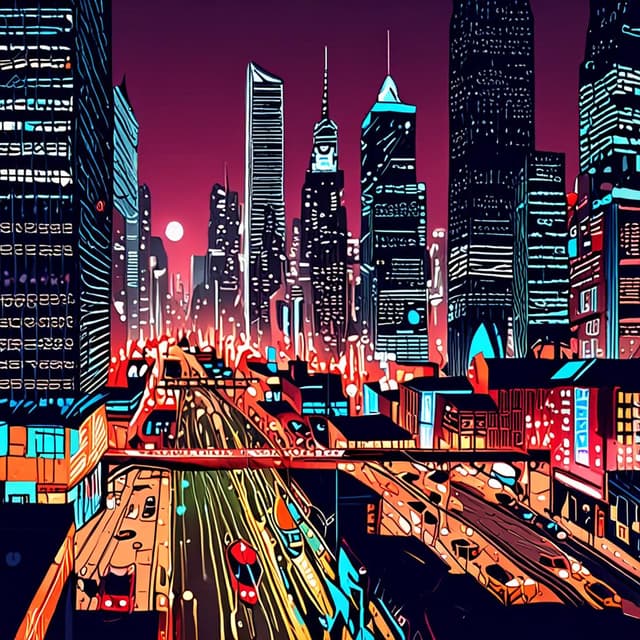
| Name | Megacity |
| Type | Largest urban center in the world |
| Key features | Technologically-advanced • Emergence of 'quirks' (genetically-encoded superpowers) • Home to corporate oligarchs, superhuman enforcers, and underground resistance movements • Complex, densely-populated landscape • Latest advancements in biotechnology, AI, and cybernetics • Entrenched power structures and growing social unrest |
Megacity is the largest urban center on the planet, a sprawling, neon-soaked metropolis that has become the epicenter of a new era defined by the emergence of "quirks" - genetically-encoded superpowers that have upended traditional power structures and redefined the boundaries of human potential.
Situated on the coast of the New Netherland continent, Megacity encompasses an area of over 10,000 square kilometers, with a population estimated to exceed 300 million residents. The city's landscape is dominated by towering skyscrapers, gleaming corporate headquarters, and dense, hyper-urbanized districts that have been built upwards rather than outwards to accommodate the staggering population.
The city's infrastructure is a complex, interconnected web of automated transport systems, energy grids, and data networks that enable the efficient movement of both people and information. Outlying suburbs and satellite cities are linked to the urban core by high-speed maglev trains and sprawling highway interchanges, while advanced drone and VTOL vehicle technology provides rapid airborne transit.
Megacity's origins can be traced back to the early 21st century, when a series of corporate mergers and acquisitions led to the consolidation of power in the hands of a few dominant megacorporations. As these entities gained increasing influence over governments and economies, they began to reshape the built environment to suit their own needs, fueling rapid urbanization and the rise of a new class of corporate oligarchs.
The turning point came with the emergence of quirks - genetically-encoded superpowers that first manifested in a small percentage of the population. These enhanced abilities quickly became commodified, with corporations racing to harness their potential and militarize the most powerful quirk-users. This sparked an era of rapid technological advancement and social upheaval that transformed Megacity into the sprawling, dystopian metropolis it is today.
Megacity's sociopolitical landscape is defined by the stark divide between the corporate elite and the struggling masses. The upper echelons of society are dominated by the executives, shareholders, and quirk-enhanced enforcers of the zaibatsu - the all-powerful megacorporations that control the city's resources and infrastructure.
These corporate overlords reside in gleaming, heavily-secured enclaves, insulated from the squalor and unrest that plagues the densely-packed urban slums where the majority of Megacity's population resides. Constant surveillance, predictive algorithms, and advanced security systems maintain a tenuous grip on social order, while public dissent is ruthlessly suppressed by corporate-backed superhuman enforcers.
However, a growing underworld of hackers, cyberpunk activists, and disenfranchised citizens has begun to fight back against the corporate hegemony. Underground resistance movements employ sophisticated technology, subversion, and even quirk-enhanced vigilantism to challenge the status quo and expose the systemic corruption that permeates Megacity's power structures.
Megacity's technological landscape is a dizzying array of cutting-edge innovations, from advanced artificial intelligence and biotechnology to pervasive cybernetics and quantum computing. The city's dominant megacorporations have poured vast resources into research and development, fueling rapid advancements that have radically transformed daily life.
Quirks and "transuman" abilities, engineered through genetic manipulation, have become the most prized and coveted technologies, with corporations vying for control over these enhanced powers. Robotics, autonomous systems, and nanotechnology also play a prominent role, powering the city's vast infrastructure and security apparatuses.
However, the rapid pace of technological change has also given rise to a thriving cyberpunk subculture, with skilled hackers, digital activists, and underground biotechnologists pushing the boundaries of what is possible. This has led to an ongoing arms race between the forces of corporate control and the champions of individual liberty, with the fate of Megacity hanging in the balance.
Megacity's meteoric rise has come at a steep cost, with the city grappling with a host of societal challenges that threaten to unravel the fragile social fabric. Rampant inequality, environmental degradation, and the dehumanizing effects of technological advancement have fueled widespread discontent and unrest among the disenfranchised masses.
The concentration of power in the hands of the corporate elite has led to the erosion of individual freedoms, with citizens constantly monitored and manipulated by pervasive surveillance systems and predictive algorithms. This has given rise to a growing resistance movement, composed of hackers, activists, and disillusioned quirk-users, who seek to challenge the status quo and expose the systemic corruption at the heart of Megacity's power structures.
As tensions escalate and the stakes continue to rise, the future of Megacity hangs in the balance, with the potential for societal collapse or radical transformation looming on the horizon. The struggle to define the city's destiny will be a pivotal battleground in the ongoing clash between corporate control and individual liberty, with the fate of humanity itself potentially hanging in the balance.